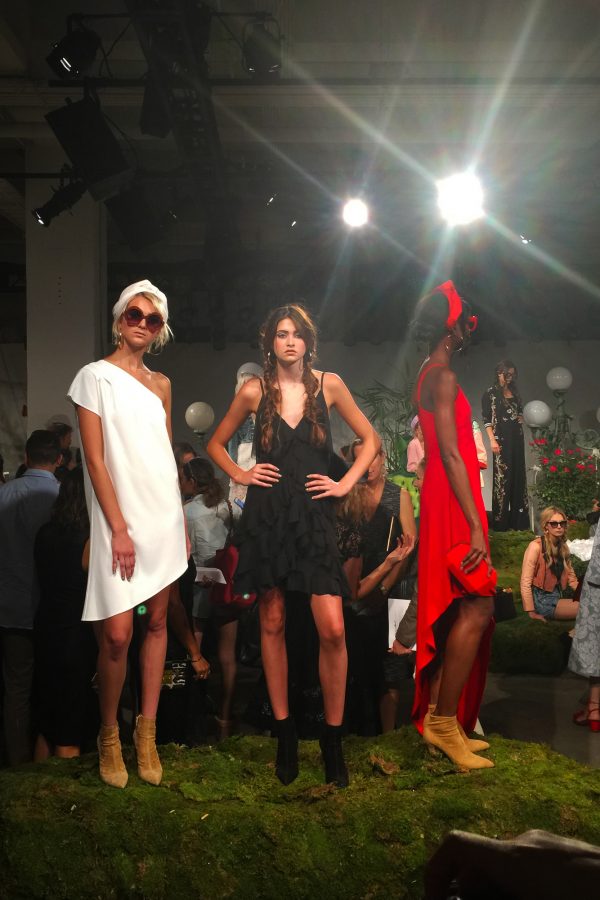How plus-sized models blazed a trail at New York Fashion Week
Models stand in designer clothing for the AO Spring 2017 Presentation during 2016 New York Fashion Week.
September 19, 2016
For many models, New York Fashion Week is the ultimate goal that starts with landing a modeling contract. For others, it’s the reality of representing the most in-demand designs of the season. And for some, it’s completely unattainable because of their size — or at least it used to be.
The biannual event always seems to make waves in the fashion world. But with the role of social media, its impact has never been more apparent for those of us lacking the accreditation to actually attend. Now, we don’t have to be at the runways; We can experience the showcases of the world’s most respected designers right from the palms of our hands.
When fans have the chance to virtually tag along, it becomes more of a global experience and not just one for the fashion insiders. Just think: What we would do if we didn’t get to witness the confusing and bizarre Yeezy fashion shows on social media?
Speaking of Kanye West’s impact on the coveted week, more and more designers are thinking outside the box when it comes to their shows. What comes to mind when you think of an NYFW show is usually rail-thin models strutting the catwalk, wearing clothes that could pay for college tuition. But some designers are starting to blaze a plus-sized trail and the message is being spread through increased social media outreach.
The rise of the supermodel in the ’90s brought figures like Kate Moss and Cindy Crawford, who set the standard for women’s beauty. But off the runway, their lives weren’t all that glittery. Supermodels became infamous for their tricks of the trade, such as smoking or doing drugs to suppress hunger to keep their waifish bodies within the realm of acceptability.
Get The Daily Illini in your inbox!
Now that the fashion world is much more transparent and accessible, NYFW has become more than just a showcase using walking mannequins. Designers are breathing life into their models by making their shows more inclusive and diverse with regards to their size, ultimately sending a message that average-sized women can wear their designs. People are paying more attention to the models and not just the clothes they’re showing off.
This year at NYFW, designer Christian Siriano sent plus-sized models, models at or above a size 12, down the runway in his show, and the whole world imploded. The topic was trending on Facebook, with a mix of surprise and praise from commenters.
“I just wanted to have different sizes,” Siriano said. “That’s all it was. But it’s great that it made such an impact; that’s awesome.”
It’s discouraging to think that in 2016, people are still shocked to see a “plus-sized” woman in a catalogue or fashion show, especially when her size represents the average American woman. But the idea of using an “average” looking model is so novel that the surprise makes sense; People are just used to seeing women model size 0 clothing.
Speaking of sizes, women’s clothing sizes differs so much amongst designers and brands that it recently sparked curiosity about all the sizing disparities.
A recent video by Vox detailed the history of women’s clothing sizes and concludes that the numbers are completely arbitrary, and the variance from brand to brand is actually a marketing strategy. A store marketed towards older women might have clothes that “run large” to make their shoppers feel better about having to go a size down, therefore making them more likely to buy their clothes.
Taking all of this into account, it seems like the fashion industry has conspired against the average woman. But seeing more plus-sized women on the runway is a sign of hope. France recently passed a law banning designers from using ultra-thin models in their shows who don’t meet a healthy BMI requirement.
The lingerie brand Aerie also recently started a campaign that omits the use of photoshop in their advertisements, and now uses more diverse and “normal” models. The hope is that younger girls will be inspired by the body diversity that Aerie promotes and will thus feel more comfortable in their own skin.
Representation has never been so important at NYFW, especially because of its relatively new global reach and audience. While there are still designers who refuse to accept wide hips and muffin tops in their shows, the trailblazers are doing the real miracle work by challenging the industry’s perceptions of “normal.”
By showcasing attainable bodies in high-end fashion shows, it shows women and especially young girls that their bodies are acceptable and worthy of even the most expensive and exclusive designs of the season — no matter what size.
Isabella is a sophomore in ACES.







